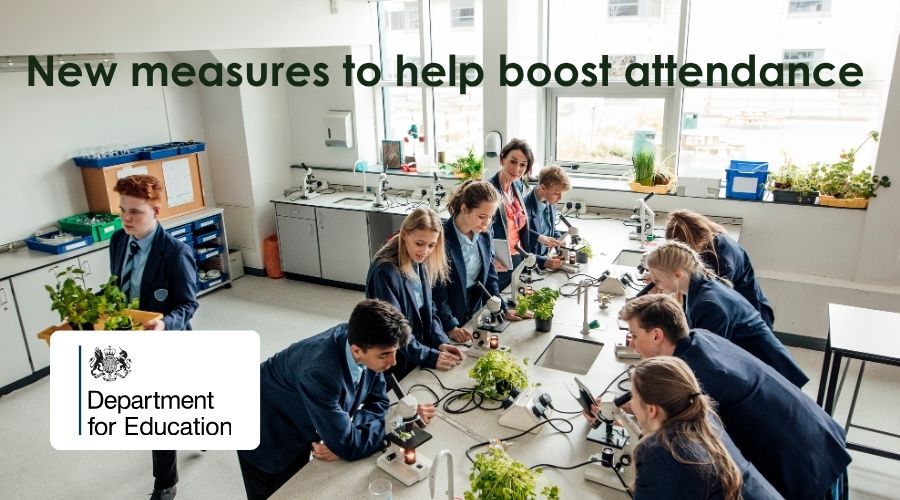
Every school to be set an individual minimum target to improve attendance and set up every child to achieve and thrive.
“The Department for Education is today (Wednesday 12th) setting out a roadmap for every school to double down on its efforts to support pupils back to class.
From this month, every school will be issued with AI-powered minimum attendance improvement targets to ensure children are in school and ready to achieve. The attendance baseline improvement expectation (ABIE) will be based on schools’ circumstances – including location, pupil needs and deprivation.”
The key changes are:
- Individual Minimum Attendance Improvement Targets (ABIE): Every school will be issued with AI-powered minimum attendance improvement targets known as the Attendance Baseline Improvement Expectation (ABIE). These targets will be tailored to the school’s circumstances, including location, pupil needs, and deprivation.
- Targeted Support and Collaboration: The Department for Education (DfE) will use data to link schools with lower attendance to high-performing schools that have similar circumstances, facilitating the sharing of best practice and support.
- New Attendance and Behaviour Hubs: 36 new Attendance and Behaviour Hubs are being launched to offer direct, one-to-one support to pupils and schools.
- Transition Best Practice Toolkit: Schools will receive a new best practice toolkit specifically designed to target critical transition periods, such as the move from primary to secondary school (Key Stage 3) and Year 7 to Year 8, which are identified as having a significant attendance drop-off.
- Addressing Barriers: The government is also continuing efforts to tackle common barriers to attendance by:
- Calling for a base level of enrichment opportunities in schools.
- Limiting branded uniform items to reduce social and financial pressure on families.
- Rolling out free breakfast clubs.
What impact are we likely to see?
The Department for Education’s new attendance roadmap establishes clear, data-driven objectives for schools, setting the stage for a strategic shift towards proactive support and engagement over the next six months.
For school leaders, the primary task involves integrating the Attendance Baseline Improvement Expectation (ABIE) targets. This is not a fixed target, but a clear, data-driven objective that necessitates rigorous analysis of the school’s specific circumstances—including deprivation and pupil needs—to inform highly targeted intervention strategies. This strategic planning also requires the proactive allocation of professional development time to engage with high-performing schools. The goal is a collaborative exchange of best practice, allowing leaders to adopt proven, context-specific engagement strategies to build more robust internal support structures.
The introduction of 36 new Attendance and Behaviour Hubs and a tailored Key Stage 3 transition toolkit offers concrete external support. Leaders are expected to actively engage with these resources, ensuring staff training is aligned with the new methodologies. The effective integration of toolkit strategies—particularly those focused on enhanced parent and pupil engagement—will be key to smoothing critical transition moments and mitigating the disengagement often linked to anxiety and poor mental health at this age.
For classroom teachers and pastoral staff, the expectation is a move toward sophisticated, early identification of disengagement rather than focusing solely on absence statistics. This means attendance planning will become a more integrated element of whole-school strategy. The renewed emphasis on providing robust enrichment opportunities and addressing practical barriers, such as limiting branded uniform items, directly supports pupil mental health by fostering a stronger sense of belonging and reducing social and financial pressure. By focusing on removing these hurdles, staff can cultivate an inclusive school environment where every child feels supported and motivated to attend.
Three Tips for Preparing for the Rollout
To transition smoothly and effectively integrate these new expectations, schools can focus on these three preparatory steps:
- Conduct a Data and Needs Audit: Before the ABIE targets are fully active, leadership teams should conduct a rigorous internal audit. Review recent attendance data to identify the reasons behind absence (e.g., anxiety, medical, transport, or family needs), not just the figures. Correlate this with pupil needs data (SEND, FSM, etc.). This prepares the school to instantly match the data-driven ABIE target with human-centred intervention strategies.
- Upskill on Early Warning Signs (CPD Focus): Invest in specific Continuing Professional Development (CPD) for all staff, especially form tutors and heads of year, focused on recognising the early emotional and behavioural indicators of disengagement and potential chronic absence. This moves beyond simply logging a sick note and ensures that early discussions with pupils and parents are empathetic, well-informed, and focused on identifying the root cause of the barrier to attendance, often linked to mental health concerns.
- Review and Map Key Stage 3 Transition: Proactively review existing Year 6-7 transition programmes and the first term of Year 7. Use the new DfE toolkit’s focus on smooth transitions to identify where extra parental or peer support can be layered in. Specifically, ensure the enrichment offer for Key Stage 3 pupils is diverse, accessible, and explicitly advertised as a core part of the school’s commitment to belonging, as this links directly to the goal of reducing disengagement anxieties.
Would you like additional support for your pastoral teams to boost attendance?

Don’t navigate big changes alone! Joining AMHIE as a member instantly connects you to essential updates on DfE policy to Reduce Risk and Stress. Eliminate professional isolation by tapping into Expert Support and shared insights from colleagues, gaining the Clarity and Direction needed for best practice. The free access delivers news and evidence-based resources, ensuring you stay ahead of the curve with confidence, supported by your peers.
Ready to connect with a supportive community and stay ahead of policy? Get immediate access to guidance and peer support—sign up for your AMHIE membership today!
